中国传统节日文化英文版
- 格式:pdf
- 大小:107.14 KB
- 文档页数:1
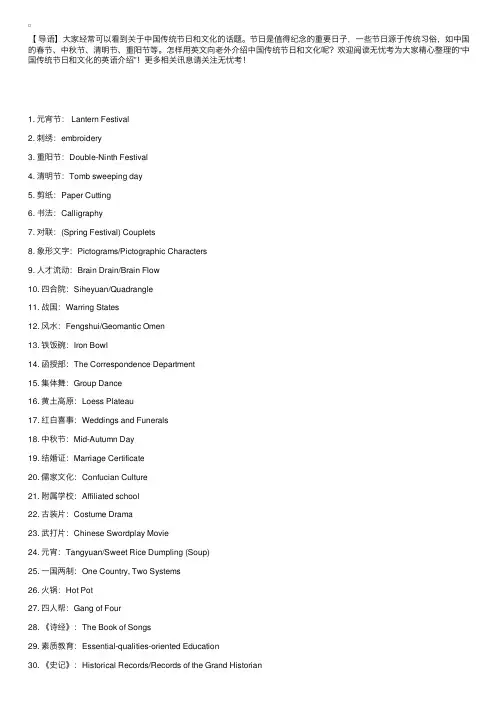
【导语】⼤家经常可以看到关于中国传统节⽇和⽂化的话题。
节⽇是值得纪念的重要⽇⼦,⼀些节⽇源于传统习俗,如中国的春节、中秋节、清明节、重阳节等。
怎样⽤英⽂向⽼外介绍中国传统节⽇和⽂化呢?欢迎阅读⽆忧考为⼤家精⼼整理的“中国传统节⽇和⽂化的英语介绍”!更多相关讯息请关注⽆忧考!1. 元宵节: Lantern Festival2. 刺绣:embroidery3. 重阳节:Double-Ninth Festival4. 清明节:Tomb sweeping day5. 剪纸:Paper Cutting6. 书法:Calligraphy7. 对联:(Spring Festival) Couplets8. 象形⽂字:Pictograms/Pictographic Characters9. ⼈才流动:Brain Drain/Brain Flow10. 四合院:Siheyuan/Quadrangle11. 战国:Warring States12. 风⽔:Fengshui/Geomantic Omen13. 铁饭碗:Iron Bowl14. 函授部:The Correspondence Department15. 集体舞:Group Dance16. 黄⼟⾼原:Loess Plateau17. 红⽩喜事:Weddings and Funerals18. 中秋节:Mid-Autumn Day19. 结婚证:Marriage Certificate20. 儒家⽂化:Confucian Culture21. 附属学校:Affiliated school22. 古装⽚:Costume Drama23. 武打⽚:Chinese Swordplay Movie24. 元宵:Tangyuan/Sweet Rice Dumpling (Soup)25. ⼀国两制:One Country, Two Systems26. ⽕锅:Hot Pot27. 四⼈帮:Gang of Four28. 《诗经》:The Book of Songs29. 素质教育:Essential-qualities-oriented Education30. 《史记》:Historical Records/Records of the Grand Historian31. ⼤跃进:Great Leap Forward (Movement)32. 《西游记》:The Journey to the West33. 除⼣:Chinese New Year’s Eve/Eve of the Spring Festival34. 针灸:Acupuncture35. 唐三彩:Tri-color Pottery of the Tang Dynasty/ The Tang Tri-colored pottery36. 中国特⾊的社会主义:Chinese-charactered Socialist/Socialist with Chinesecharacteristics37. 偏旁:radical38. 孟⼦:Mencius39. 亭/阁: Pavilion/ Attic40. ⼤中型国有企业:Large and Medium-sized State-owned Enterprises41. *:gunpowder42. 农历:Lunar Calendar43. 印/玺:Seal/Stamp44. 物质精神⽂明建设:The Construction of Material Civilization and Spiritual Civilization45. 京剧:Beijing Opera/Peking Opera46. 秦腔:Crying of Qin People/Qin Opera47. 太极拳:Tai Chi48. 独⽣⼦⼥证:The Certificate of One-child49. 天坛:Altar of Heaven in Beijing50. ⼩吃摊:Snack Bar/Snack Stand51. 红双喜:Double Happiness52. 政治辅导员:Political Counselor/School Counselor53. 春卷:Spring Roll(s)54. 莲藕:Lotus Root55. 追星族:Star Struck56. 故宫博物院:The Palace Museum57. 相声:Cross-talk/Comic Dialogue58. 下岗:Lay off/Laid off59. 北京烤鸭:Beijing Roast Duck60. ⾼等⾃学考试:Self-taught Examination of Higher Education61. *:fireworks and firecracker62. 敦煌莫⾼窟:Mogao Caves63. 电视⼩品:TV Sketch/TV Skit64. ⾹港澳门同胞:Compatriots from Hong Kong and Macao65. *:Cultural Revolution66. 长江中下游地区:The Mid-low Reaches of Yangtze River67. 门当户对:Perfect Match/Exact Match68. 《⽔浒》:Water Margin/Outlaws of the Marsh69. 中外合资企业:Joint Ventures70. ⽂房四宝(笔墨纸砚):"The Four Treasure of the Study" "Brush, Inkstick, Paper, and Inkstone"71.兵马俑:cotta Warriors/ Terracotta Army72.旗袍:cheongsam。
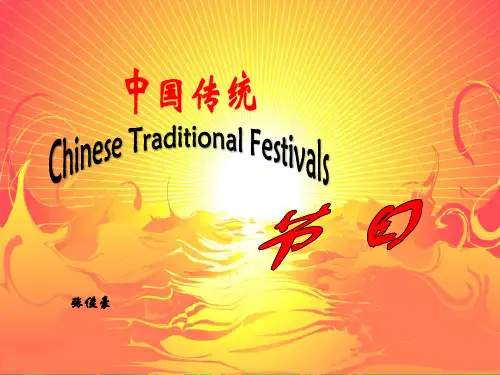
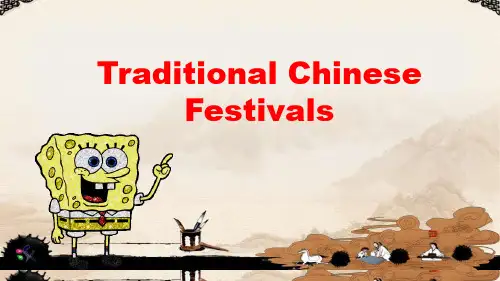
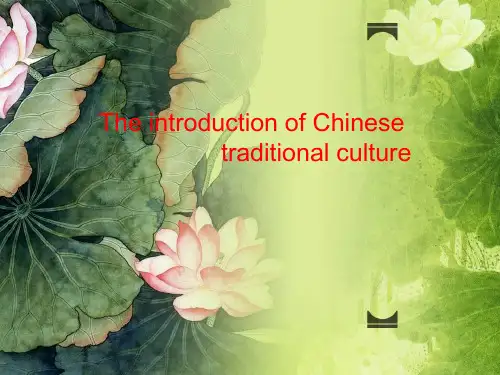
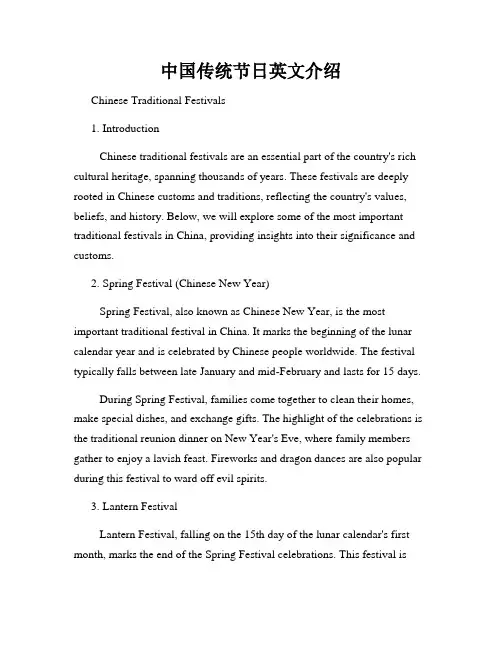
中国传统节日英文介绍Chinese Traditional Festivals1. IntroductionChinese traditional festivals are an essential part of the country's rich cultural heritage, spanning thousands of years. These festivals are deeply rooted in Chinese customs and traditions, reflecting the country's values, beliefs, and history. Below, we will explore some of the most important traditional festivals in China, providing insights into their significance and customs.2. Spring Festival (Chinese New Year)Spring Festival, also known as Chinese New Year, is the most important traditional festival in China. It marks the beginning of the lunar calendar year and is celebrated by Chinese people worldwide. The festival typically falls between late January and mid-February and lasts for 15 days.During Spring Festival, families come together to clean their homes, make special dishes, and exchange gifts. The highlight of the celebrations is the traditional reunion dinner on New Year's Eve, where family members gather to enjoy a lavish feast. Fireworks and dragon dances are also popular during this festival to ward off evil spirits.3. Lantern FestivalLantern Festival, falling on the 15th day of the lunar calendar's first month, marks the end of the Spring Festival celebrations. This festival ischaracterized by the display of colorful lanterns and various cultural activities.People often write riddles on their lanterns for others to solve, adding an element of fun and intellectual challenge to the festival. The iconic lanterns take many forms, including those shaped like animals, flowers, or famous landmarks. Watching the lanterns light up the night sky is a mesmerizing experience.4. Dragon Boat FestivalThe Dragon Boat Festival, also known as Duanwu Festival, is celebrated on the fifth day of the fifth lunar month. This festival commemorates the famous poet Qu Yuan and is characterized by the exciting racing of dragon boats.Dragon boat races involve teams of rowers paddling vigorously to the beat of a drum, competing to reach the finish line first. These races attract huge crowds of spectators who cheer and encourage the participants. Another significant tradition of this festival is the consumption of sticky rice dumplings called zongzi, which are wrapped in bamboo leaves.5. Mid-Autumn FestivalThe Mid-Autumn Festival, also known as the Moon Festival, is celebrated on the 15th day of the eighth lunar month. This festival is a time for family reunions and the appreciation of the full moon's beauty.The festival is closely associated with the legend of Chang'e, a celestial being who resides on the moon. During this festival, people gather to enjoy mooncakes, round pastries filled with various sweet or savory fillings.Lanterns in the shape of the moon are also prevalent during this festival, adding to the festive atmosphere.6. ConclusionChinese traditional festivals are not only grand celebrations but also an embodiment of the Chinese people's cultural identity and historical roots. Through these festivals, people reaffirm their bonds with family, pay respects to ancestors, and pass down customs and traditions to future generations.As China continues to modernize, it remains essential to preserve and cherish these traditional festivals as they play a vital role in maintaining cultural cohesion and fostering a sense of national unity. By understanding and appreciating these festivals, one can gain a deeper insight into the rich cultural tapestry of China.。
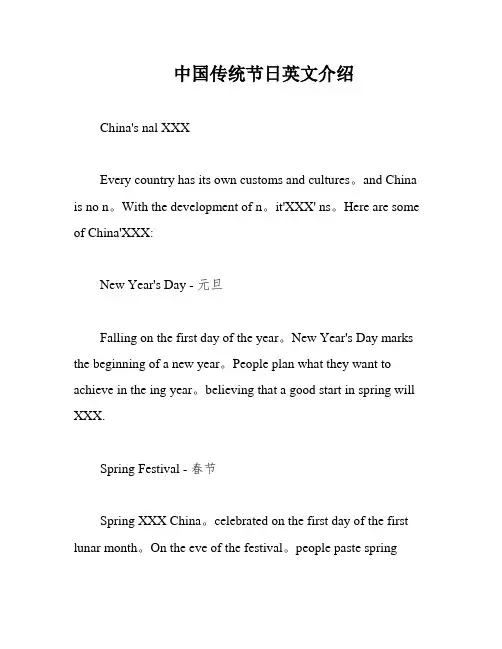
中国传统节日英文介绍China's nal XXXEvery country has its own customs and cultures。
and China is no n。
With the development of n。
it'XXX' ns。
Here are some of China'XXX:New Year's Day - 元旦Falling on the first day of the year。
New Year's Day marks the beginning of a new year。
People plan what they want to achieve in the ing year。
believing that a good start in spring will XXX.Spring Festival - 春节Spring XXX China。
celebrated on the first day of the first lunar month。
On the eve of the festival。
people paste springpoems with lucky words and prepare us food。
with dumplings being a must。
They also clean their house。
but avoid XXX.Lantern Festival - 元宵节XXX day of the first lunar month。
People XXX written on them。
They also eat sweet glutinous rice balls。
called XXX。
XXX and happiness.Dragon Boat Festival - 端午节XXX of the poet Qu Yuan。

Traditional Festivals in ChinaT raditional festivals are important events in the life of every Chinese, beginning right from childhood. Festivals such as the Chinese New Year, the Dragon Boat Festival, the Mid-Autumn Festival, and the Winter Solstice are more or less evenly distributed across the four seasons. In China's traditional agricultural society, festivals served to mark the passing of time.L et's take a close look to these festivals:The Lantern FestivalT he Lantern Festival is on the 15th of the first lunar month. That night there is a full moon, and every household is decorated with colorful lanterns and prepares yuanxiao. Yuan Xiao, a kind of round dumpling make of glutinous rice flour sweet or salted fillings, which is boiled or fired. Yuan Xiao, literally "the night of the first full moon", which is another name for the festival. When night falls, people go into the street, where exquisite lanterns of diverse designs are hung. Some are pasted with riddles for the passers-by to solve.I t is said that after the Yuan Dynasty (1206-1368) destroyed the Jin (1115-1234), the band of the Yuan army celebrated the victory with gongs and drums. Since then beating gongs and drums has been a local tradition to express joy and happiness.I n the country and town, people celebrate it heartily. For some reason, there is often a bigger celebration in the rural areas, especially in the North. The most popular food for this festival is yuanxiao. Apart from yuanxiao, the customary foods vary from place to place. In Shanxi Province, people take yuanxiao tea, a sort of soup made of boiled flour mixed with vegetables and fruits; in Luoyang and Lingbao, Henan Province, people favor jujube paste; in Kunming, Yunnan Province, people prefer bean dough. Other folk customs of the Lantern Festival include attending the lantern fair, guessing riddles and performing traditional festivities.Dragon boat festivalVarious perfume bags glutinous rice dumpling (zongzi)The Spring festivalFamily CelebrationO n the last day of the old year, everyone was busy either in preparing food for the next two days, or in going to the barbers and getting tidied up for the New Year’s Day. Tradition stipulated that all food be pre-pared before the New Year’s Day, so that all sharp instruments, such as knives and scissors, could be put away to avoid cutting the "luck" of the New Year. The kitchen and well were not to be disturbed on the first day of the Year. The New Year’s Eve and New Year’s Daycelebrations were strickly family affairs. All members of the family would gather for the impo rtant family meal on the evening of the New year’s Eve. Even if a family member could not attend, an empty seat would be kept to symbolize that person’s presence at the banquet. At midnight following the banquet, the younger members of the family would bow and pay their respects to their parents and elders.Lai-SeeO n New Year’s Day, the children were given Red Lai-See Envelopes , good luck money wrapped in little red envelopes. On New Year’s day, everyone had on new clothes, and would put on his best behavior. It was considered improper to tell a lie, raise one’s voice, use indecent language, or break anything on the first day of the year. Starting from the second day, people began going out to visit friends and relatives, taking with them gifts and Lai-See for the children. Visitors would be greeted with traditional New year delicacies, such as melon seeds, flowers, fruits, tray of togetherness, and NIANGAO, New Year cakes.The moon festivalO n the 15th day of the 8th month of the lunar calendar, there is a Harvest moon. Some countries call it Harvest Festival. Here in China, they call it the Mid-Autumn festival, Chinese culture is deeply imbedded in traditional festivals. Just like Christmas and Thanksgiving in the West, the Moon Festival is one of the most important traditional events for the Chinese.T he Moon Festival is full of legendary stories. Legend says that Chang Er flew to the moon, where she has lived ever since. You might see her dancing on the moon during the Moon Festival.T he Moon Festival is also an occasion for family reunions. When the full moon rises, families get together to watch the full moon, eat moon cakes, and sing moon poems. With the full moon, the legend, the family and the poems, you can't help thinking that this is really a perfect world. That is why the Chinese are so fond of the Moon Festival.A s every Chinese holiday is accompanied by some sort of special food. on the Moon Festival, people eat moon cakes, a kind of cookie with fillings of sugar, fat, sesame, walnut, the yoke of preserved eggs, ham or other material. Some moon cakes are of very high quality and very delicious. An overseas tourist is advised not to miss it if he or she happens to be in China during the Moon Festival.T he Moon Festival is also a romantic one. A perfect night for the festival is if it is a quiet night without a silk of cloud and with a little mild breeze from the sea. Lovers spend such a romantic night together tasting the delicious moon cake with some wine while watching the full moon.T here are also many other traditional festivals in China, such as The Chinese Valentine's day(七夕节—中国情人节),Double Ninth Day (重阳节) and Water Sprinkling Day (傣族泼水节)H ope all the Chinese traditional festivals will bring you happiness.。

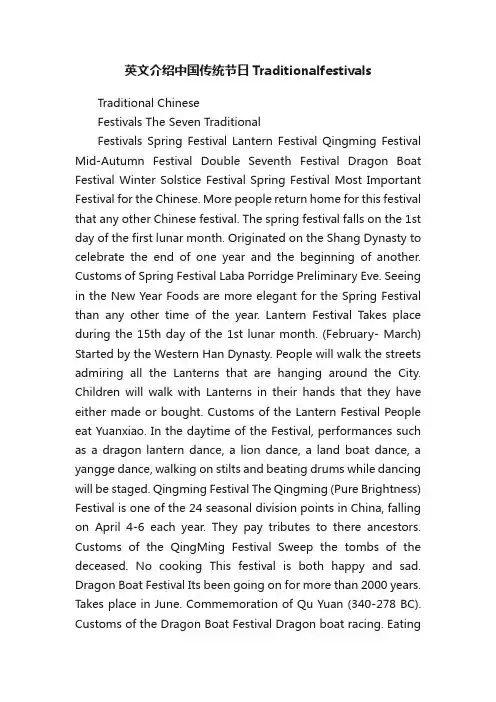
英文介绍中国传统节日TraditionalfestivalsTraditional ChineseFestivals The Seven TraditionalFestivals Spring Festival Lantern Festival Qingming Festival Mid-Autumn Festival Double Seventh Festival Dragon Boat Festival Winter Solstice Festival Spring Festival Most Important Festival for the Chinese. More people return home for this festival that any other Chinese festival. The spring festival falls on the 1st day of the first lunar month. Originated on the Shang Dynasty to celebrate the end of one year and the beginning of another. Customs of Spring Festival Laba Porridge Preliminary Eve. Seeing in the New Year Foods are more elegant for the Spring Festival than any other time of the year. Lantern Festival Takes place during the 15th day of the 1st lunar month. (February- March) Started by the Western Han Dynasty. People will walk the streets admiring all the Lanterns that are hanging around the City. Children will walk with Lanterns in their hands that they have either made or bought. Customs of the Lantern Festival People eat Yuanxiao. In the daytime of the Festival, performances such as a dragon lantern dance, a lion dance, a land boat dance, a yangge dance, walking on stilts and beating drums while dancing will be staged. Qingming Festival The Qingming (Pure Brightness) Festival is one of the 24 seasonal division points in China, falling on April 4-6 each year. They pay tributes to there ancestors. Customs of the QingMing Festival Sweep the tombs of the deceased. No cooking This festival is both happy and sad. Dragon Boat Festival Its been going on for more than 2000 years. Takes place in June. Commemoration of Qu Yuan (340-278 BC). Customs of the Dragon Boat Festival Dragon boat racing. Eatingzongzi. Drinking realga. Double Seventh Festival Takes place 7th day of the Seventh Lunar Month Festival full of romance. The legend is carried on with a story of two stars at opposite ends of the milky way. Customs of the Double Seventh have weekend over the years but is still carried on in some rural areas. Mid-Autumn Festival Falls on the 15th day of 8th lunar month. (October) In Mid-Autumn they honor the moon. People express there feelings. Customs of the Mid- Autumn Festival Show longing for a more prosperous life. Today people will enjoy the full moon and eat moon cakes on that day. This day was chosen because of the fullness of the moon at this time. Winter Solstice Festival Was started over 2500 years ago. Takes place on December 22 or 23. This is the shortest day light hours of any day of the year. Good things will become stronger and stronger after this day. People gather and eat food and celebrate that daylight hours are gettinglonger. Conclusion These are the main festivals of the Chinese culture. There are many others the are celebrated but many of there old traditions have been lost over the years. * * *。
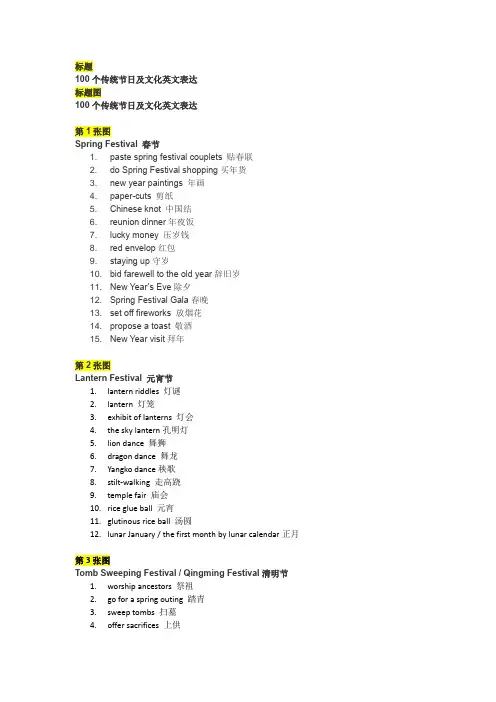
标题100个传统节日及文化英文表达标题图100个传统节日及文化英文表达第1张图Spring Festival 春节1. paste spring festival couplets 贴春联2. do Spring Festival shopping买年货3. new year paintings 年画4. paper-cuts 剪纸5. Chinese knot 中国结6. reunion dinner年夜饭7. lucky money 压岁钱8. red envelop红包9. staying up守岁10. bid farewell to the old year辞旧岁11. New Year’s Eve除夕12. Spring Festival Gala春晚13. set off fireworks 放烟花14. propose a toast 敬酒15. New Year visit拜年第2张图Lantern Festival 元宵节ntern riddles 灯谜ntern 灯笼3.exhibit of lanterns 灯会4.the sky lantern孔明灯5.lion dance 舞狮6.dragon dance 舞龙7.Yangko dance秧歌8.stilt-walking 走高跷9.temple fair 庙会10.rice glue ball 元宵11.glutinous rice ball 汤圆12.lunar January / the first month by lunar calendar正月第3张图Tomb Sweeping Festival / Qingming Festival清明节1.worship ancestors 祭祖2.go for a spring outing 踏青3.sweep tombs 扫墓4.offer sacrifices 上供5.burn incense 焚香6.martyr烈士7.public cemetery 公墓8.green rice ball青团9.cudweed herb rolls 清明果10.Cold Food Day 寒食节第4张图Dragon Boat Festival 端午节1. glutinous rice dumplings 粽子2. realgar wine 雄黄酒3. sachet 香包4. hang mugwort and calamus 插艾蒿、菖蒲5. hang up icons of Zhong Kui 悬钟馗像6. dispel diseases and viruses 驱病驱恶7. dragon boat racing 赛龙舟8. The Lament 《离骚》9. commemorate纪念10. Qu Yuan 屈原11. patriotic poet 爱国诗人12. state of Chu 楚国13. Warring States Period 战国时期14. Miluo River 汨罗江第5张图Double Seventh Festival 七夕节1. Qiqiao Festival 乞巧节2. mythology 神话传说3. folktale 民间故事4. a bridge of magpies鹊桥5. the Milky Way 银河6. Niulang (cowherd) 牛郎7. Zhinv (weaver maid) 织女8. Vega 织女星9. Altair 牛郎星10. matchmaker 月老11. heavenly palace 天宫12. needlework 女红13. thread the needles 穿针第6张图Ghost Festival / Zhongyuan Festival 中元节1. Yulan Festival盂兰节2. Buddhist and Taoist festival 佛教、道教节日3. folk religion 民间宗教4. Ghost Month(the seventh month)鬼月5. lower realm 阴界6. deity 神7. worship ancestors 祭祖8. prepare offerings 备供品9. incense burner香炉10. set lanterns on the river 放河灯11. burn joss paper 烧纸钱第7张图Mid-Autumn Festival 中秋节1. lunar calendar 阴历2. solar calendar 阳历3. mooncake 月饼4. altar 祭坛5. appreciate the moon 赏月6. worship the moon 拜月7. full moon满月8. auspicious吉祥9. reunion 团圆10. Chang'e / Goddess of the moon嫦娥11. Chang'e Flying to the Moon嫦娥奔月12. The Jade Rabbit玉兔13. Cherry Bay 月桂14. elixir 灵丹妙药第9张图Double Ninth Festival 重阳节1. wear cornel twigs 插茱萸2. dogwood 山茱萸3. chrysanthemum cake 菊糕4. five-color cake 五色糕5. enjoy chrysanthemum flowers 赏菊6. drink chrysanthemum wine 喝菊花酒7. eat double-ninth cakes 吃重阳糕8. ascend heights 登高9. climb mountains 爬山10. have family reunion 家庭团聚11. visit senior citizens 拜访老人。
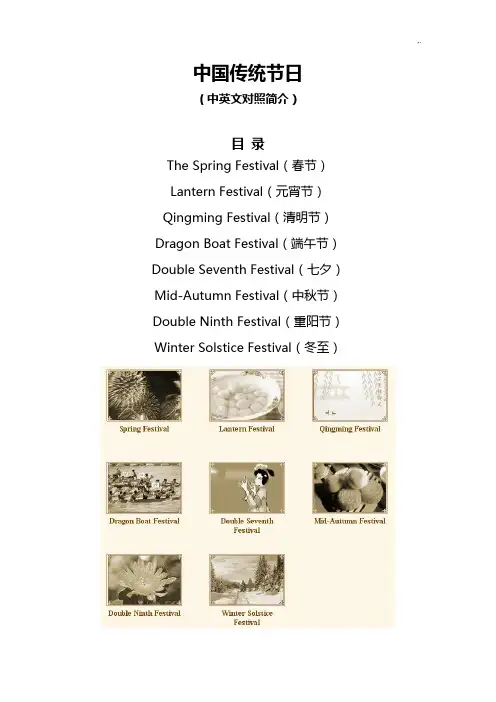
中国传统节日(中英文对照简介)目录The Spring Festival(春节)Lantern Festival(元宵节)Qingming Festival(清明节)Dragon Boat Festival(端午节)Double Seventh Festival(七夕)Mid-Autumn Festival(中秋节)Double Ninth Festival(重阳节)Winter Solstice Festival(冬至)The Spring Festival(春节)The first day of the first lunar month is the New Year in the Chinese lunar calendar. Among the traditional Chinese festivals, this is the most important and the most bustling. Since it occurs at the end of winter and the beginning of spring, people also call it the Spring Festival.Chinese have many traditional customs relating to the Spring Festival. Since the 23rd day of the 12th lunar montha, people start to prepare for the event. Every family will undertake thorough cleaning, do their Spring Festival shopping, create paper-cuts for window decoration, put up New Year picturesb, write Spring Festival coupletsc, make New Year cakesd, and also prepare all kinds of food to bid farewell to the old and usher in the new.New Year's Eve is the time for a happy reunion of all family members, when they sit around the table to have a sumptuous New Year's Eve dinner, talking and laughing, until daybreak, which is called "staying up to see the year out". When the bell tolls midnight on New Year's Eve, people eat dumplings. In ancient times, midnight was called zishi (a period of the day from 11 p.m. to 1 a.m.). Dumplings (jiaozi) are eaten because it sounds the same as "change of the year and the day" in Chinese.From the first day of the lunar year, people pay New Year calls on relatives and friends, which is an important custom for the Spring Festival.Setting off firecrackers is the favorite activity of children in the Spring Festival. According to legend, this could drive off evil spirits. The continuous sound of firecrackers can be heard everywhere, adding to the atmosphere of rejoicing and festivity.Many places hold temple fairs. The wonderful dragon lantern dance and the lion dance performances, along with various handicraft articles and local snacks attract thousands of people.With the development of the times, some changes have taken place inthe customs of spending the Spring Festival. For example, to prevent environmental pollution, many cities have banned firecrackers. But this does not have an impact on the happy atmosphere of the festival. On New Year's Eve, family members get together to have dinner while watching TV programs.For Chinese at home and abroad, the Spring Festival is always the most important festival.农历的正(zheng)月初一,是中国的农历新年。
中国传统节日及西方节日英文版国家或国际节日元旦New Year' s Day (January 1)国际劳动妇女节International Working women' s Day / Women's Day (Mar 8)国际劳动节International Labor Day / May. Day (May 1)中国青年节Chinese Youth Day (May 4)国际儿童节International Children's Day / Children's Day (June 1)中国共产党诞生纪念日( 党的生日)Anniversary of the Founding of the Chinese Communist Party / the Party' s Birthday (July 1)建军节Army Day (August 1)教师节Teachers’ Day (September 1)国庆节National Dey (October 1)中国传统节日春节the Spring Festival (New Year’s Day of the Chinese lunar calendar)农历正月初一元宵节(灯节) the Lantern Festival 农历正月十五清明节the Qing Ming Festival 四月五日前后端午节the Dragon-Boat Festival 农历五月初五中秋节the Mid-Autumn Festival / (the Moon Festival)农历八月十五重阳节the Double Ninth Festival 农历九月初九植树节(3月12日) Tree Planting Day除夕New Year's Eve 农历十二月三十日阳历节日1月1日元旦(New Year's Day)2月2日世界湿地日(World Wetlands Day)2月14日情人节(Valentine's Day)3月3日全国爱耳日3月5日青年志愿者服务日3月8日国际妇女节(International Women' Day)3月9日保护母亲河日3月12日中国植树节(China Arbor Day)3月14日白色情人节(White Day)3月14日国际警察日(International Policemen' Day)3月15日世界消费者权益日(World Consumer Right Day)3月21日世界森林日(World Forest Day)3月21日世界睡眠日(World Sleep Day)3月22日世界水日(World Water Day)3月23日世界气象日(World Meteorological Day)3月24日世界防治结核病日(World Tuberculosis Day)4月1日愚人节(April Fools' Day)4月5日清明节(Tomb-sweeping Day)4月7日世界卫生日(World Health Day)4月22日世界地球日(World Earth Day)4月26日世界知识产权日(World Intellectual Property Day)5月1日国际劳动节(International Labour Day)5月3日世界哮喘日(World Asthma Day)5月4日中国青年节(Chinese Youth Day)5月8日世界红十字日(World Red-Cross Day)5月12日国际护士节(International Nurse Day)5月15日国际家庭日(International Family Day)5月17日世界电信日(World Telecommunications Day)5月20日全国学生营养日5月23日国际牛奶日(International Milk Day)5月31日世界无烟日(World No-Smoking Day)6月1日国际儿童节(International Children's Day)6月5日世界环境日(International Environment Day)6月6日全国爱眼日6月17日世界防治荒漠化和干旱日(World Day to combat desertification)6月23日国际奥林匹克日(International Olympic Day)6月25日全国土地日6月26日国际禁毒日(International Day Against Drug Abuse and Illicit Trafficking)7月1日中国共产党诞生日(Anniversary of the Founding of the Chinese Communist Party) 7月1日国际建筑日(International Architecture Day)7月7日中国人民抗日战争纪念日7月11日世界人口日(World Population Day)8月1日中国人民解放军建军节(Army Day)8月12日国际青年节(International Youth Day)9月8日国际扫盲日(International Anti-illiteracy Day)9月10日中国教师节(Teacher's Day)9月16日中国脑健康日9月16日国际臭氧层保护日(International Day for the Preservation of the Ozone Layer)9月20日全国爱牙日9月21日世界停火日(World Cease-fire Day)9月27日世界旅游日(World Tourism Day)10月1日中华人民共和国国庆节(National Day)10月1日国际音乐日(International Music Day)10月1日国际老年人日(International Day of Older Persons)10月4日世界动物日(World Animal Day)10月5日世界教师日(World Teachers' Day)(联合国教科文组织确立)10月8日全国高血压日10月9日世界邮政日(World Post Day)10月10日世界精神卫生日(World Mental Health Day)10月14日世界标准日(World Standards Day)10月15日国际盲人节(International Day of the Blind)10月15日世界农村妇女日(World Rural Women's Day)10月16日世界粮食日(World Food Day)10月17日国际消除贫困日(International Day for the Eradication of Poverty)10月24日联合国日(United Nations Day)10月24日世界发展新闻日(World Development Information Day)10月28日中国男性健康日10月29日国际生物多样性日(International Biodiversity Day)10月31日万圣节(Halloween)11月8日中国记者节11月9日消防宣传日11月14日世界糖尿病日(World Diabetes Day)11月17日国际大学生节11月25日国际消除对妇女的暴力日(International Day For the elimination of Violence against Women)12月1日世界爱滋病日(World AIDS Day)12月3日世界残疾人日(World Disabled Day)12月4日全国法制宣传日12月9日世界足球日(World Football Day)12月25日圣诞节(Christmas Day)12月29日国际生物多样性日(International Biological Diversity Day)1月最后一个星期日国际麻风节3月最后一个完整周的星期一中小学生安全教育日春分月圆后的第一个星期日复活节(Easter Monday)(有可能是3月22-4月25日间的任一天) 5月第二个星期日母亲节(Mother's Day)5月第三个星期日全国助残日6月第三个星期日父亲节(Father's Day)9月第三个星期二国际和平日(International Peace Day)9月第三个星期六全国国防教育日9月第四个星期日国际聋人节(International Day of the Deaf)10月的第一个星期一世界住房日(World Habitat Day)10月的第二个星斯一加拿大感恩节(Thanksgiving Day)10月第二个星期三国际减轻自然灾害日(International Day for Natural Disaster Reduction)10月第二个星期四世界爱眼日(World Sight Day)11月最后一个星期四美国感恩节(Thanksgiving Day)农历节日农历正月初一春节(the Spring Festival)农历正月十五元宵节(Lantern Festival)农历五月初五端午节(the Dragon-Boat Festival)农历七月初七乞巧节(中国情人节)(Double-Seventh Day)农历八月十五中秋节(the Mid-Autumn Festival)农历九月初九重阳节(the Double Ninth Festival)农历腊月初八腊八节(the laba Rice Porridge Festival)农历腊月二十四传统扫房日。
中国传统节日-文化的盛大庆典Traditional Chinese Festivals -A Glorious Celebration of CultureIn China, traditional festivals play an indispensablerole in preserving the rich cultural heritage and fostering a strong sense of unity among its people. These festivities are not only an occasion for jubilation but also serve as a bridge connecting generations, passing down age-old customs and beliefs. Let'sexplore some of the most significant traditionalfestivas:Spring Festival (春节): Also known as the Chinese New Year, it marks the beginning of the lunaryear and is celebrated with grandeur. Families reunite, and streets dazzle with vibrant red lanterns anddecorations symbolizing prosperity and luck. The highlight of the festival is the awe-inspiring dragon and lion dances that captivate spectators. Lantern Festival (元宵节): Falling on the 15th day of the lunar year, this joyful festival sees cities adorned with beautifully crafted lanterns. Riddles written on the lanterns add an element of intellectual fun to the celebrations. A must-try delicacy is "tangyuan," sweet rice dumplings, symbolizing unity and harmony within families.Qingming Festival (清明节): During this solemn occasion, Chinese people pay tribute to their ancestors by cleaning and tidying their gravesites. The serene atmosphere is also filled with the flying of kites, making it a day of both remembrance and rejoicingDragon Boat Festival (端午节): Commencing with the exhilarating dragon boat races, this festival commemorates the ancient poet Qu Yuan. People savor "zongzi," pyramid-shaped glutinous rice wrapped in bamboo leaves, while the fragrance of medicinal herbs fills the air to ward off diseases.Qixi Festival (七夕节): Often referred to as the Chinese Valentine's Day, Qixi celebrates the legendary love story of the Cowherd and the Weaver Girl. Star-crossed lovers unite on this romantic day, and the skies shimmer with colorful fireworks.Mid-Autumn Festival (中秋节): Under the radiance of the full moon, families gather to enjoy mooncakes and pomelos, symbolizing unity and good fortune. The festival is a time for expressing gratitude and reuniting with loved ones.Double Ninth Festival (重阳节): On this day, people ascend to high places to appreciate the beauty of autumn and pay respects to the elderly. Chrysanthemums, a symbol of longevity, are given as gifts, and hiking in nature is a popular activity.Winter Solstice Festival (冬至节): As the longest night of the year, it marks the return of longer daylight hours. Families indulge in warming foods like dumplings and tangyuan, signifying a prosperous and bountiful year ahead.Lunar New Year's Eve (除夕): On the last day of the lunar year, families come together for a lavish reunion dinner. The festivities reach their zenith with the joyous display of fireworks, symbolizing the expulsion of evil spirits.These festivals exemplify the deep-rooted cultural values and traditions of China, reflecting the nation's enduring commitment to preserving its heritage. Each event brings people closer, fostering harmony and appreciation for the customs that have withstood the test of time.中国传统节日-文化的盛大庆典在中国,传统节日对于保护丰富的文化遗产和培养人们的团结感起着不可或缺的作用。
《传统节日和习俗》小学英语作文(中英文实用版)Traditional Festivals and CustomsIn China, there are many traditional festivals and customs that have been passed down from generation to generation.These festivals and customs are an important part of our culture and history.One of the most important traditional festivals in China is the Spring Festival, also known as Chinese New Year.It is the longest and most important festival in China, lasting for 15 days.People celebrate the festival by cleaning their homes, wearing new clothes, and decorating their homes with red lanterns and couplets.We also gather with family and friends to have a big feast and exchange gifts.Fireworks and dragon and lion dances are also common during the festival.Another important traditional festival is the Dragon Boat Festival, which falls on the fifth day of the fifth month of the Chinese lunar calendar.People celebrate the festival by eating sticky rice dumplings wrapped in bamboo leaves, which symbolize good luck and health.Dragon boat races are also held to honor the memory of the famous poet Qu Yuan.The Mid-Autumn Festival is another important traditional festival in China.It is celebrated on the 15th day of the eighth month of the Chinese lunar calendar.People gather with family and friends to admire the fullmoon, eat mooncakes, and enjoy the beautiful night sky.These are just a few examples of the many traditional festivals and customs in China.Each festival has its own unique customs and traditions, which are passed down from generation to generation.They are an important part of our culture and history, and we should cherish and protect them.。
Chinese festivals cultureAfter the folk worship generally half of the offerings for
Boat Festival 61The Dragon Boat Festival the 5th day of the 5th lunar month has had a h 6161唐文秀61616161.61端午节为每年龙历五月初五又称端
阳节、龙舟节、女儿节、午日节、五月节、艾节、端五、重五、夏节、
天中节、浴兰节、屈原日、诗人节等。
与春节、清明节、中秋节并称为
中国汉族的四大传统节日。
61端午节的来源有多种多样但最被人们接
受的是端午节是用来纪念著名爱国诗人屈原的。
据说屈原于五月初五自
投汨罗江死后为蛟龙所困世人哀之每于此日投五色丝粽子于水中以驱蛟
龙。
端午节包粽子的习俗由此而来。
1.吃粽子
Zongzi as the traditional food for the Dragon Boat Festival is a pyramid-
shaped dumpling made of glutinous rice and wrapped in bamboo or reed leaves to give it a 饮雄黄酒61Realgar wine雄黄酒
61It is a very popular practice to drink this kind ofChinese liquor seasoned with realgar a 佩饰
61On Dragon Boat Festival parents also need to dress their children up with a perfume p shaped canoes pulling the oars harmoniously and hurriedly accompanied by rapid drums s religious semi-entertaining program from theWarring States Period 475-
221 BC. 61A typical dragon boat ranges from 50-
100 feet in length with a beam of about 5.5 feet accommodating two paddlers seated side b 采药这是最古老的端午节俗之一。
如湖北监利于端午“采百草”亦采药草
之俗。
采药是因端午前后草药茎叶成熟药性好才于此日形成此俗。
61
沐兰汤。
端午日洗浴兰汤是《大戴礼》记载的古俗。
当时的兰不是现在
的兰花而是菊科的佩兰有香气可煎水沐浴。
61采茶、制凉茶。
北方一
些地区喜于端午采嫩树叶、野菜叶蒸晾制成茶叶。
广东潮州一带人们去
郊外山野采草药熬凉茶喝。
这对健康也有好处。
61挂花草。
在端午设
置种种可驱邪的花草。